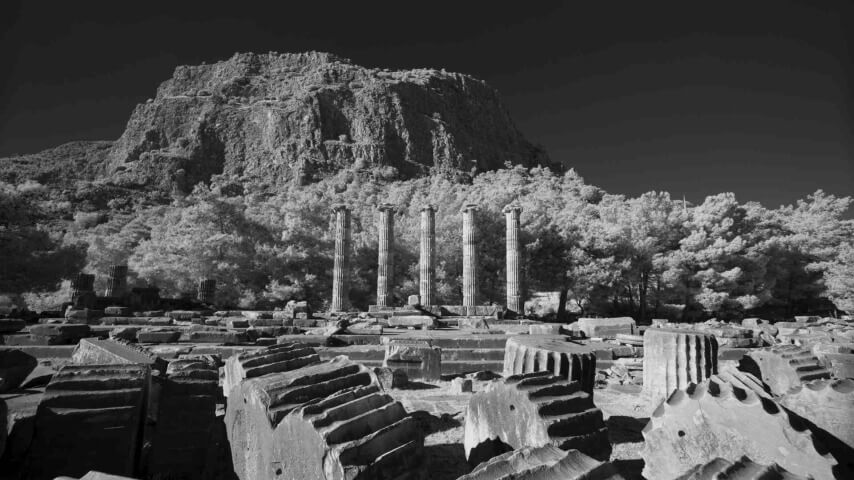The quiet, engrossing, moody documentaries of Viktor Kossakovsky have previously focused on some of the most powerful forces affecting humanity, like water (Aquarela) and cute little pigs (Gunda). Now the writer-director turns to another subject broad enough to project existential questions on while marveling at its terrifying beauty: Rocks. Big rocks, little rocks. Rocks that fall, rocks that remain upright as structures for thousands of years. The underlying architectural thesis of Architecton, as laid out in the press notes, is that “concrete is catastrophic,” but that its earthen ingredients are more humble, sustainable, and majestic. As Kossakovsky’s contemplative images envelop the vision and spark the mind, his film mines profundity from beneath our feet.
Despite the connotations of the film’s title—which refers to Kazimir Malevich’s abstract constructions, War And Peace‘s concept of a higher power, and the Greek word meaning “master builder”—Architecton finds itself more preoccupied with destruction than creation. The aggressively inorganic lines recently highlighted in The Brutalist give way to the jagged, organic edges of erosion. The camera scans down collapsed apartments like the cross-sections of dollhouses, and ogles free-standing pillars supporting only air like they’re pieces of Hyperart Thomasson. The idea of people being “master builders” takes on an immediate irony amid so many shots of dilapidated structures, of landfills, and of concrete, the production of which eats mountains. But this isn’t an arthouse episode of How It’s Made. It’s a moving mural painted with stone instead of on stone, depicting chaos reclaiming order, celebrating entropy and damning the devastation wreaked upon the planet by humanity.
The natural reclamation of our works can be sped up—the aftermath of a Turkish earthquake also conjures up the specter of warfare, in Ukraine and Gaza—or contentedly slow—ants and turtles crawl next to the ruins of an ancient temple in Lebanon. But it is, as the movie almost wordlessly explains, inevitable. It eats away at fire-scarred paint jobs and allows weeds to flourish on staircases. It turns lonely archways into complex gravestones memorializing the existence of their builders. And it transforms concrete rubble back into peaked piles, mountains regrowing out of the dump.
Some of this is shot in black and white, some in slow motion. All of it is staggering. The most hypnotic and psychedelic of these sections simply watch gravity in action. An endless landslide cascades down the screen like a waterfall. Rocks and dust, frozen in the air, resemble the universe expanding out from The Big Bang. A fantasia of wet, muddy pebbles bounce to a rhythm, leaping across a conveyor belt in an absurd, animalistic dance. Piles of fluted column fragments are reflected in the ridges of a rock crusher, the sequences combining into as kaleidoscopic a succession as any nature doc that dives the depths of the oceans or searches the outer reaches of space, centering matter so mundane as to be a nuisance in the bottom of your shoe.
These arresting images, heady aims—given voice directly in a climactic conversation with Italian architect Michele De Lucchi, who spends most of the film putting together an evocative piece of garden landscaping—and impressively odd sounds (from Evgueni Galperine, whose whistles and whispers and thrumming brass do as much heavy lifting as the raw music of cracking, crumbling earth) make Architecton into a spectacle that could bury you. If one watched the film stoned (ha ha), its mesmerizing simplicity and thunderous impact might be even more moving. But viewed stone-cold sober, its 98 minutes still fly by with a defiant lightness.
“Why do we build ugly, boring buildings if we know how to build beautiful ones?” asks De Lucchi near the end of the film. In virtually every aspect of our lives, the prioritization of short-term over long-term is more severe than ever. Quick profits, easy answers, AI artwork. Architecton acknowledges that everything we do is fleeting. There’s meaning in that. But it also posits that putting thought and respect into our temporary, tiny changes to Earth—laying fertile foundations that can roll with the punches that will always come—has a higher virtue. It allows not just for severe, black-and-white cycles of creation and destruction, but smooth evolutions that incorporate all that came before. This is the way that a building, a community, even a website covering pop culture, can weather the violence of time.
Director: Viktor Kossakovsky
Writer: Viktor Kossakovsky
Release Date: August 1, 2025

